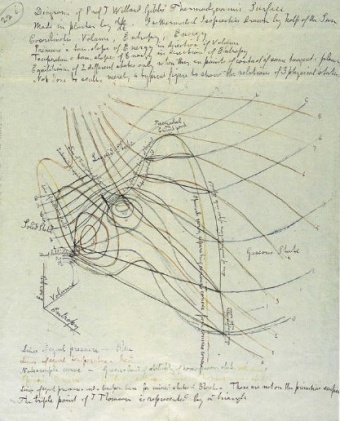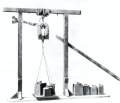Category:Fields, waves & electromagnetics
Background
The relationship between magnetic and electrical fields provides the foundational theory of electrical engineering. While naturally occurring electrical phenomenon such as lightning, static electricity and the shocks of various fishes and eels have been observed in the ancient world, the formal study and understanding of electric phenomenon began with William Gilbert's work on magnetism, culminating in his 1600 paper "On the Lodestone; Magnetic Bodies; and the Great Magnet, the Earth". Benjamin Franklin's many significant discoveries and Luigi Galvani's discovery of bioelectricity would follow in the 1700s, and in the early 1800s André-Marie Ampère and Hans Christian Ørsted discovered the link between electricity and magnetism, which were formalized by Maxwell's laws in 1873. These laws form the mathematical basis for practically the entire field of electrical engineering and its developments. The pure fields and waves aspects are still very commonly used today in applications such as antennas, microwaves and radio astronomy.
The IEEE Antennas and Propagation Society, IEEE Electromagnetic Compatibility Society, IEEE Magnetics Society, IEEE Microwave Theory and Techniques Society publish technical journals related to electromagnetic fields and waves.
STARS Articles
IEEE STARS articles are peer-reviewed articles on the history of major developments in electrical and computer science and technology. Available in the fields, waves & electromagnetics category are:
Subcategories
- Antennas - A transducer which may receive or send signals by waves
- Electromagnetics - The link between electricity and magnetism
- Electromagnetic compatibility - the study of unintentional generation, propagation and reception of electromagnetic energy
- Electromagnetic devices - various devices which use electromagnetic components, such as speakers, tape heads, electric motors, etc
- Electromagnetic fields - the field produced by moving electrically charged objects
- Electromagnetic induction - the process of generating an electric current via moving a conductor through a magnetic field
- Electromagnetic shielding - the process of reducing the electromagnetic field in a certain space by the use of conductors or magnets
- Interference - A combination of multiple waves which results in a new waveform
- Magnetic devices - Various types of magnetic devices including accelerator magnets, magnetic cores and solenoids
- Magnetic fields - Topics related specifically to magnetic fields including geomagnetism and toroidal magnetic fields
- Magnetic materials - Materials which are naturally magnetic such as ferrites and garnets
- Magnetics - Topics pertaining to magnetics as a whole
- Masers - a device that produces coherent electromagnetic waves through amplification of emission, originally an acronym for Microwave Amplification by Stimulated Emission of Radiation
- Microwave technology - Technology which applies microwaves including microwave amplifiers, bands and circuits
- Millimeter wave technology - The highest radio frequency band, topics in the category include millimeter wave devices, circuits and communication
- Radio astronomy - The field of astronomy which explores space by using radio frequencies and waves
- Resonance - Oscillation of a system at higher rates at certain frequencies
- Submillimeter wave technology - Electromagnetic radiation with a frequency between 300 and 3000 GHz
Subcategories
This category has the following 18 subcategories, out of 18 total.
A
E
M
Pages in category "Fields, waves & electromagnetics"
The following 324 pages are in this category, out of 324 total.
A
- Archives:A Brief Survey of Microwave Measurements
- Richard B. Adler
- Andrew Alford
- Oral-History:David W. Allan
- Wilhelm Altar
- Oral-History:Edward Altshuler
- Andre-Marie Ampère
- First-Hand:An Electrophysicist's Role in Academia and Star Wars
- Diogenes J. Angelakos
- IEEE Antennas and Propagation Society History
- John W. Arthur
- Oral-History:Werner F. Auerbacher
- Hertha Ayrton
B
- Constantine A. Balanis
- Harold M. Barlow
- Wilmer Barrow
- Nikolai G. Basov
- Carl Edward Baum
- Ernst Berg
- Harold H. Beverage
- Oral-History:Harold H. Beverage and H. O. Peterson
- Oral-History:Harold S. Black
- Oral-History:Nicolaas Bloembergen
- Jean-Charles Bolomey
- Oral-History:Berthold Bosch
- Amar G. Bose
- Jagadish Chandra Bose
- George Brown
- William C. Brown
- Edmond Bruce
- John H. Bryant
- Archives:Bulk Wave Microwave Devices
- William Burroughs
- Archives:But What's the Use of It, Mr. Faraday?
- Oral-History:Joe Butler
C
- Milestones:Callan's Pioneering Contributions to Electrical Science and Technology, 1836
- Philip Carter
- G.S. Peter Castle
- CAT, MRI, and Ultrasound
- Cavity Magnetron
- Cell Phone Antenna Links
- Oral-History:Milton Chaffee
- Oral-History:Charles Maerfeld
- Weng Cho Chew
- Oral-History:Marvin Chodorow
- Wilbur Norman (Chris) Christiansen
- Seymour B. Cohn
- Paul Coleman
- William Fothergill Cooke
- Oral-History:William E. Cory
- Cosmic Background Radiation
- Oral-History:Donald Cox
- Malcolm R. Currie
- C. Chapin Cutler
- Oral-History:C. Chapin Cutler
D
- Raymond Damadian
- Richard Damon
- Oral-History:Lee Davenport
- Archives:The Inventions of Thomas Davenport
- Oral-History:Donald Davies & Derek Barber
- Adrianus de Hoop
- Degaussing
- Nabeel Aly Omar Demerdash
- Oral-History:Charles Denton
- Robert Dicke
- Alton C. Dickieson
- Milestones:Directive Short Wave Antenna, 1924
- Displacement Current
- Oral-History:Herbert Doring
E
- Edison and Ore Refining
- Early Applications of Electricity
- Archives:Electricity, The Magic Medium
- Archives:EMC Founders War Stories
- IEEE Electromagnetic Compatibility Society History
- Electromagnetic Environmental Effects (E3)
- Archives:Electromagnetic Interference - A Global Engineering Challenge
- Electromagnetic Waves
- Electromagnetism
- Electromagnets
- Nader Engheta
- Oral-History:Lloyd Espenschied
- Etheric Force
F
- Michael Faraday
- Faraday's Law
- Moses G. Farmer
- Leopold B. Felsen
- Milestones:Development of Ferrite Materials and Their Applications, 1930-1945
- Ferrites
- Milestones:First Satellite Broadcasting to the Public
- First-Hand:My First Handmade Radio
- Oral-History:Joseph Fischer
- Oral-History:Virgilio Floriani
- Ronald Foster
- Oral-History:Ted Foster
- Oral-History:Kathryn and Charles Fowler
- A. Gardner Fox
- Fractal Antennas
- Giorgio Franceschetti
- Milestones:Benjamin Franklin's work in London, 1757-1775
- Milestones:Book “Experiments and Observations on Electricity” by Benjamin Franklin, 1751
- C. S. Franklin
- Milestones:Virginia Smith High-Voltage Direct-Current Converter Station, 1988
- Elizabeth J. French
- Harald T. Friis
G
- Carl Friedrich Gauss
- Gauss' Law
- Oral-History:David Geselowitz
- Oral-History:Ivan A. Getting (1991)
- Georgios B. Giannakis
- Oral-History:Edward Ginzton
- Edward L. Ginzton
- Peter Glaser
- Oral-History:Frank W. Godsey
- Oral-History:Adolf Goetzberger
- Oral-History:Eugene Gordon
- Eugene I. Gordon
- Oral-History:John Granger
- Oral-History:William Gretsch
- Oral-History:John Guarrera
H
- Geomagnetism and Edmond Halley (1656-1742)
- Hammond B3 Organ
- Robert C. Hansen
- William W. Hansen
- Oral-History:Charles Harper
- Hermann A. Haus
- Oral-History:Izuo Hayashi
- Oral-History:Fred Heath
- Oliver Heaviside
- Archives:Papers of Oliver Heaviside
- Joseph Henry
- Ralph Hiatt
- History that weren't so: Myths and Misperceptions
- Oral-History:Wallace Hoff
- Oral-History:Karl Honaman
- Archives:Papers of Edwin J. Houston
- Vernon Hughes
- Hy-Gain TH7DX Antenna
- Hyperthermia: Microwaves as Cancer Treatment
I
K
L
M
- Some Popular Misconceptions About Magnetic Recording History and Theory
- Magnetic-Core Memory
- IEEE Magnetics Society History
- Magnetism in the Greco-Roman World
- Nathan Marcuvitz
- Augustus Matthiessen
- First-Hand:Maxum Memoirs: Climbing Technical Mountains
- Milestones:Maxwell's Equations, 1860-1871
- Oral-History:Ferdy Mayer
- Ronald McFarlan
- Edward V. McMahon
- Oral-History:James McNaul
- Oral-History:Wolfgang Mecklenbrauker
- Kenneth K. Mei
- Holger H. Meinel
- Oral-History:Mary Tsingou Menzel
- Oral-History:Lou Meren
- IEEE Microwave Theory & Technology Society History
- Archives:Microwave Acoustics
- Microwave Circuits
- Archives:Microwave Integrated Circuits
- Microwave Link Networks
- Microwave Ovens
- Microwave Radiometer
- Oral-History:Julian Z. Millar
- Milestones:First Millimeter-wave Communication Experiments by J.C. Bose, 1894-96
- Millimeter Waves
- Raj Mittra
- William W. Mumford
N
O
P
- Demetrius T. Paris
- Oral-History:Kumar Patel
- Clayton R. Paul
- Arno Allan Penzias
- John Pierce
- Oral-History:John Pierce
- Oral-History:John Pierce (Part 2)
- Oral-History:John Pierce (Part 3)
- Oral-History:Kenneth Plante
- Aleksandr Popov
- Gerald Posakony
- Oral-History:Robert Pound
- Archives:Papers of George B. Prescott
- Walter E. Proebster
- Oral-History:Walter Proebster
- Archives:Papers of Michael I. Pupin
- Oral-History:Edward Purcell
R
- Milestones:Mount Fuji Radar System, 1964
- Radar tracking
- Radio
- Beginnings of radio astronomy
- Radio Telescope
- Radio Waves
- Milestones:Discovery of Radioconduction by Edouard Branly, 1890
- Milestones:NAIC/Arecibo Radiotelescope, 1963
- Oral-History:Ralph Strong
- Oral-History:William Rambo
- Oral-History:Simon Ramo
- Simon Ramo
- Oral-History:Norman F. Ramsey (1991)
- Grote Reber
- Louis W. Roberts
- Oral-History:Randal Robertson
- Oral-History:Ulrich L. Rohde
- Oral-History:Ian Ross
- Alan Rudge
- Victor H. Rumsey
- Oral-History:John Douglass Ryder
S
- Oral-History:Theodore Saad
- Oral-History:Harold Scherer
- Oral-History:Manfred Schroeder
- Tomy Sebastian
- Oral-History:Franz Seifert
- Thomas B. A. Senior
- First-Hand:Serendipity and Superconducting Magnets
- SETI
- Oral-History:Hans Severin
- Raghunath K. Shevgaonkar
- Milestones:Long-Range Shortwave Voice Transmissions from Byrd's Antarctic Expedition, 1934
- Oral-History:Ralph M. Showers
- Keeve M. Siegel
- Samuel Silver
- Simple Electric Motor
- Oral-History:Kenneth F. Slater
- First-Hand:Slide Rule Gives Flight to Tracking Antenna
- Oral-History:William Smanko
- Oral-History:Chester Smith
- Philip Smith
- Smith Chart
- Oral-History:Allan Whitenack Snyder
- Oral-History:Jack Spangler
- Oral-History:John Staehlin
- Archives:State of the Art Avalanche Diode Microwave Sources
- Oral-History:Karl Ulrich Stein
- Oral-History:Irving Stokes
- Archie W. Straiton
- Oral-History:Guy Suits
T
- Oral-History:Keiji Tachikawa
- Allen Taflove
- Chen To Tai
- Gerald Tape
- Albert H. Taylor
- Bernard Tellegen
- First-Hand:Telstar... and some personal recollections
- Archives:The Fundamental Sources of Radiation
- Oral-History:Leonard Thomas Sr.
- Archives:Papers of Silvanus P. Thompson
- Thordarson 1 MV transformer
- Oral-History:Charles H. Townes (1992)
- Charles Townes
- Oral-History:Charles Townes (1991)
- Archives:From Radar Bombing Systems to the Maser: Charles Townes as Electrical Engineer
- Transcontinental Telephone Service
- Transcontinental Television Network (U.S.)
- Leung Tsang
V
W
- Oral-History:Glen Wade
- Waveguides
- Archives:Bridger of Cultures: Ernst Weber as Researcher, Educator, and Statesman
- Oral-History:Ernst Weber (1988)
- Oral-History:Ernst Weber (1991)
- Wilhelm Eduard Weber
- Oral-History:Roger Webster
- Oral-History:Herbert Weiss
- Archives:From Automatic Volume Control to the Stationmaster Antenna: Harold Alden Wheeler and Applied Electronics
- Oral-History:Harold Wheeler (1991)
- John R. Whinnery
- Oral-History:John Whinnery
- Werner Wiesbeck
- Jerome B. Wiesner
- Wilkinson Microwave Anisotropy Probe (WMAP)
- Robert Wilson
- Donald R. Wilton
- Oral-History:Irving Wolff
- Bernard E. Wrensch
Y
Media in category "Fields, waves & electromagnetics"
The following 3 files are in this category, out of 3 total.
- 3103-kennedy antenna.jpg 1,200 × 1,492; 128 KB
- Henry Electromagnet 1020.jpg 560 × 480; 34 KB
- Nosich-cavmag2010.pdf ; 483 KB


